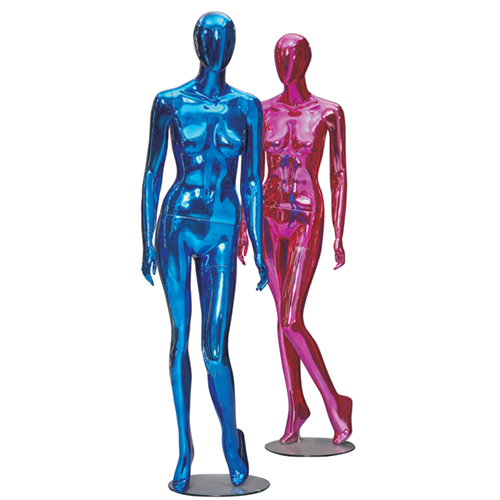
Prop is an important tool to support the display. The design and production of props is an important factor in displaying the artistic effect of the window, and its hidden mystery cannot be ignored.
The purpose of using props is to better attract the attention of consumers, make the window taste infinite and highlight the artistic effect. For some commonly used ordinary clothing, the peculiar idea of props will play a crucial role in attracting customers' attention.
On the commercial street of the Caesars Hotel in Las Vegas, there is a lingerie store. It installs a pair of huge wings behind the model props, turning the props into beautiful angels and placing them in the center of the store front door, attracting consumers , so that people who have no intention to buy underwear also come to appreciate it, so as to achieve the purpose of promoting underwear.
The mystery here is: if the underwear is displayed on ordinary props, the area is small and only three points, it is difficult to rely on the product itself to attract the attention of consumers from a distance, and then it is necessary to rely on props. Clothes model manufacturer's clothing window props are peculiar and beautiful in shape, which can condense the eyes.
In a department store in Tokyo, Japan, models dressed in clothing exhibits are placed on the stationary steps between the up and down escalators. While customers going up and down the elevator, plastic models can browse the fashions on the models, which is more efficient.
Invisibility of props
The simplification of props has become a trend, and even the invisibility of props, not only feels fashionable, but also highlights the product itself and the quality of the product. At the Korea International Fashion Exhibition, there is a booth specializing in selling silk square scarves and woven scarves. The props used are to draw simple line drawings on transparent and crisp plastic molds, cut them according to the outline, and hang them with nylon silk. On the top of the exhibition, the position of the props is at the same level as people's sight. The scarf is draped over the shoulders. With the support of this transparent invisible prop, the clothing model manufacturer expresses the beautiful texture of the scarf material to the fullest.
A hat store used a similar simple wire lamp holder as a prop, and placed exquisite hats on it. The clothing window props are both creative and highlight the product. The well-known shorts store in Beverly in the United States adopts another method of invisible props, almost only seeing the pants without the props, and the product effect is clear.
In the window of a department store in Osaka, Japan, the head of the model is woven with metal wire. The illusion of the head makes the customer feel novel and avant-garde, and makes the customer pay more attention to the product itself, which leads to the product itself. Trendy and fashionable association.

Unified props and patterns
The mystery of unifying the props lies in the full application of the "repetition is memory" thinking law. The famous French brand LV has made the window of the Champs-Elysée in Paris the world leader. The clothing window props are almost used in the United States, Japan, South Korea and China. The same form of props. This leverages the trick of repetition, prompting consumers to remember their brand well.
Using the same pattern as the background can also play a role in deepening the customer's memory. There are thousands of clothing samples. The tops have one collar, two sleeves, and the trousers have two legs, which are not easy to distinguish. This requires designing a beautiful pattern or LOGO to help memory. Make consumers remember your brand through patterns. American and Japanese windows use this technique to specifically design a decorative pattern to be reused in the window backing, and mannequins are indeed an ingenious way to impress.
Milan, Italy, the EMILIOPUCCI store in Las Vegas, the United States, and the underground shopping mall in Nagoya, Japan all use this method.
Cultural foil
Use high-end artworks or replicas of cultural relics to foil the atmosphere of product culture and create cultural interest. A clothing store in Beverly Hills, USA, imitates the oil paintings of world famous people, but the color purity is reduced, close to monochrome, forming a very harmonious and unified tone, the props and characters are put on high-end clothing, interspersed in the environment of appreciating oil paintings and artworks. The elegance of oil painting and the nobility of oil painting, products and art treasures are integrated together, and the artistic taste and style of products have reached a high degree of sublimation. Of course, in addition to famous paintings, cultural and recreational items can also be used as decorations to set off the characteristics of the products. In a window on Culture Street in Seoul, South Korea, dice are used as background props to create a casual atmosphere for clothing.